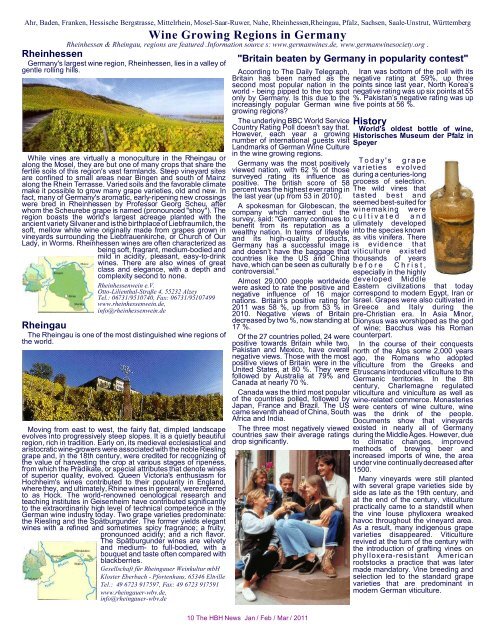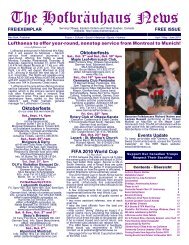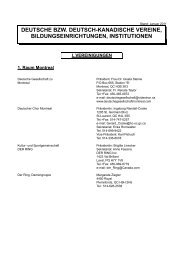Joyful Voices - Das Rote Mikrofon - Hofbräuhaus News
Joyful Voices - Das Rote Mikrofon - Hofbräuhaus News
Joyful Voices - Das Rote Mikrofon - Hofbräuhaus News
Create successful ePaper yourself
Turn your PDF publications into a flip-book with our unique Google optimized e-Paper software.
Ahr, Baden, Franken, Hessische Bergstrasse, Mittelrhein, Mosel-Saar-Ruwer, Nahe, Rheinhessen,Rheingau, Pfalz, Sachsen, Saale-Unstrut, Württemberg<br />
Wine Growing Regions in Germany<br />
Rheinhessen & Rheingau, regions are featured .Information source s: www.germanwines.de, www.germanwinesociety.org .<br />
Rheinhessen<br />
Germany's largest wine region, Rheinhessen, lies in a valley of<br />
gentle rolling hills.<br />
While vines are virtually a monoculture in the Rheingau or<br />
along the Mosel, they are but one of many crops that share the<br />
fertile soils of this region's vast farmlands. Steep vineyard sites<br />
are confined to small areas near Bingen and south of Mainz<br />
along the Rhein Terrasse. Varied soils and the favorable climate<br />
make it possible to grow many grape varieties, old and new. In<br />
fact, many of Germany's aromatic, early-ripening new crossings<br />
were bred in Rheinhessen by Professor Georg Scheu, after<br />
whom the Scheurebe grape is named (pronounced "shoy"). The<br />
region boasts the world's largest acreage planted with the<br />
ancient variety Silvaner and is the birthplace of Liebfraumilch, the<br />
soft, mellow white wine originally made from grapes grown in<br />
vineyards surrounding the Liebfrauenkirche, or Church of Our<br />
Lady, in Worms. Rheinhessen wines are often characterized as<br />
being soft, fragrant, medium-bodied and<br />
mild in acidity, pleasant, easy-to-drink<br />
wines. There are also wines of great<br />
class and elegance, with a depth and<br />
complexity second to none.<br />
Rheinhessenwein e.V.<br />
Otto-Lilienthal-Straße 4, 55232 Alzey<br />
Tel.: 06731/9510740, Fax: 06731/95107499<br />
www.rheinhessenwein.de,<br />
info@rheinhessenwein.de<br />
Rheingau<br />
The Rheingau is one of the most distinguished wine regions of<br />
the world.<br />
Moving from east to west, the fairly flat, dimpled landscape<br />
evolves into progressively steep slopes. It is a quietly beautiful<br />
region, rich in tradition. Early on, its medieval ecclesiastical and<br />
aristocratic wine-growers were associated with the noble Riesling<br />
grape and, in the 18th century, were credited for recognizing of<br />
the value of harvesting the crop at various stages of ripeness,<br />
from which the Prädikate, or special attributes that denote wines<br />
of superior quality, evolved. Queen Victoria's enthusiasm for<br />
Hochheim's wines contributed to their popularity in England,<br />
where they, and ultimately, Rhine wines in general, were referred<br />
to as Hock. The world-renowned oenological research and<br />
teaching institutes in Geisenheim have contributed significantly<br />
to the extraordinarily high level of technical competence in the<br />
German wine industry today. Two grape varieties predominate:<br />
the Riesling and the Spätburgunder. The former yields elegant<br />
wines with a refined and sometimes spicy fragrance; a fruity,<br />
pronounced acidity; and a rich flavor.<br />
The Spätburgunder wines are velvety<br />
and medium- to full-bodied, with a<br />
bouquet and taste often compared with<br />
blackberries.<br />
Gesellschaft für Rheingauer Weinkultur mbH<br />
Kloster Eberbach - Pfortenhaus, 65346 Eltville<br />
Tel.: 49 6723 917597, Fax: 49 6723 917591<br />
www.rheingauer-wbv.de,<br />
info@rheingauer-wbv.de<br />
"Britain beaten by Germany in popularity contest"<br />
According to The Daily Telegraph,<br />
Britain has been named as the<br />
second most popular nation in the<br />
world - being pipped to the top spot<br />
only by Germany. Is this due to the<br />
increasingly popular German wine<br />
growing regions?<br />
The underlying BBC World Service<br />
Country Rating Poll doesn't say that.<br />
However, each year a growing<br />
number of international guests visit<br />
Landmarks of German Wine Culture<br />
in the wine growing regions.<br />
Germany was the most positively<br />
viewed nation, with 62 % of those<br />
surveyed rating its influence as<br />
positive. The british score of 58<br />
percent was the highest ever rating in<br />
the last year (up from 53 in 2010).<br />
A spokesman for Globescan, the<br />
company which carried out the<br />
survey, said: "Germany continues to<br />
benefit from its reputation as a<br />
wealthy nation. In terms of lifestyle<br />
and its high-quality products,<br />
Germany has a successful image<br />
and doesn’t have the baggage that<br />
countries like the US and China<br />
have, which can be seen as culturally<br />
controversial."<br />
Almost 29,000 people worldwide<br />
were asked to rate the positive and<br />
negative influence of 16 major<br />
nations. Britain’s positive rating for<br />
2011 was 58 %, up from 53 % in<br />
2010. Negative views of Britain<br />
decreased by two %, now standing at<br />
17 %.<br />
Of the 27 countries polled, 24 were<br />
positive towards Britain while two,<br />
Pakistan and Mexico, have overall<br />
negative views. Those with the most<br />
positive views of Britain were in the<br />
United States, at 80 %. They were<br />
followed by Australia at 79% and<br />
Canada at nearly 70 %.<br />
Canada was the third most popular<br />
of the countries polled, followed by<br />
Japan, France and Brazil. The US<br />
came seventh ahead of China, South<br />
Africa and India.<br />
The three most negatively viewed<br />
countries saw their average ratings<br />
drop significantly.<br />
10 The HBH <strong>News</strong> Jan / Feb / Mar / 2011<br />
Iran was bottom of the poll with its<br />
negative rating at 59%, up three<br />
points since last year, North Korea’s<br />
negative rating was up six points at 55<br />
%. Pakistan’s negative rating was up<br />
five points at 56 %.<br />
History<br />
World's oldest bottle of wine,<br />
Historisches Museum der Pfalz in<br />
Speyer<br />
Today's grape<br />
varieties evolved<br />
during a centuries-long<br />
process of selection.<br />
The wild vines that<br />
tasted best and<br />
seemed best-suited for<br />
winemaking were<br />
cultivated and<br />
ulimately developed<br />
into the species known<br />
as vitis vinifera. There<br />
is evidence that<br />
viticulture existed<br />
thousands of years<br />
before Christ,<br />
especially in the highly<br />
developed Middle<br />
Eastern civilizations that today<br />
correspond to modern Egypt, Iran or<br />
Israel. Grapes were also cultivated in<br />
Greece and Italy during the<br />
pre-Christian era. In Asia Minor,<br />
Dionysus was worshipped as the god<br />
of wine; Bacchus was his Roman<br />
counterpart.<br />
In the course of their conquests<br />
north of the Alps some 2,000 years<br />
ago, the Romans who adopted<br />
viticulture from the Greeks and<br />
Etruscans introduced viticulture to the<br />
Germanic territories. In the 8th<br />
century, Charlemagne regulated<br />
viticulture and viniculture as well as<br />
wine-related commerce. Monasteries<br />
were centers of wine culture, wine<br />
was the drink of the people.<br />
Documents show that vineyards<br />
existed in nearly all of Germany<br />
during the Middle Ages. However, due<br />
to climatic changes, improved<br />
methods of brewing beer and<br />
increased imports of wine, the area<br />
under vine continually decreased after<br />
1500.<br />
Many vineyards were still planted<br />
with several grape varieties side by<br />
side as late as the 19th century, and<br />
at the end of the century, viticulture<br />
practically came to a standstill when<br />
the vine louse phylloxera wreaked<br />
havoc throughout the vineyard area.<br />
As a result, many indigenous grape<br />
varieties disappeared. Viticulture<br />
revived at the turn of the century with<br />
the introduction of grafting vines on<br />
phylloxera-resistant American<br />
rootstocks a practice that was later<br />
made mandatory. Vine breeding and<br />
selection led to the standard grape<br />
varieties that are predominant in<br />
modern German viticulture.
















